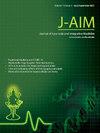A traditional Cameroonian spice, Syzygium guineense curtails leukemia tumor growth through G2-M cell cycle arrest and predicted NLRP3 inflammasome pathway
IF 1.9
Q3 INTEGRATIVE & COMPLEMENTARY MEDICINE
引用次数: 0
Abstract
Background
S. guineense DC. var. macrocarpum (Engl.) F. White. plant has been a traditional Cameroonian spice used as medicine to treat several health conditions such as liver cirrhosis, vaginal infections, and cancer.
Objective
This study aims to investigate the anti-cancer effects of Syzygium guineense plant parts on leukemia preclinical models.
Material and methods
Crude extracts and fractions of S. guineense were tested to inhibit the proliferation of human leukemia cells and reduce tumor volume in leukemia xenograft KG1 in immunodeficient mice. Further active fractions were evaluated for the mechanism of action using cell cycle analysis. Inflammasome markers, key targets of chronic inflammation, were screened from phytoconstituents obtained by LC-MS analysis. Of these, putative compounds having potential anticancer efficacy were assessed for kinetic binding with Molecular docking using PyRx-Python Prescription 0.8, and molecular dynamics simulations were performed by GROMACS 22.04.
Results
Bark extract B2 and leaf fractions L4/L5 exhibited significant (P < 0.001) anticancer activity against leukemia cells in a dose-dependent manner. Mechanistically, in L4/L5 arrested HL-60 cells at G2/M phase (population increased to >25 % at drug concentration up to 80 μg/ml compared to 8.8 % in control cells), while B2 caused S phase arrest (population increased to 56.2 % at drug concentration up to 100 μg/ml compared to 45.8 % in control) in HL60 cells. L4/L5 treatment led to apoptosis induction in these cells. B2 (P=0.035) and L4 (P=0.096) significantly reduced the tumor xenograft KG1 in the animal model. HRMS allowed the identification of Betulinic Acid/Oleanolic Acid in L4. Computational prediction and GROMACS simulations of these compounds revealed stable binding patterns between the component and target proteins NLRP3 and NEK-7 over 100 ns.
Conclusion
Our study has provided interesting leads that Cameroonian spice S. guineense fractions/extract exhibited anti-leukemia activity, which could be mediated by inhibiting the innate immune inflammasome pathway. The study emphasizes the importance of S. guineense plant parts that have the potential to be developed for novel targeted therapeutics for leukemia.
作为喀麦隆的一种传统香料,几内亚香通过G2-M细胞周期阻滞和预测NLRP3炎性体途径抑制白血病肿瘤的生长
背景。guineense直流。变种大carpum(英文)f .白色。这种植物一直是喀麦隆的一种传统香料,被用作治疗肝硬化、阴道感染和癌症等几种健康状况的药物。目的探讨豚鼠合欢植物部位对白血病临床前模型的抗癌作用。材料与方法研究豚鼠粗提物及提取物对免疫缺陷小鼠白血病移植瘤KG1细胞增殖的抑制作用及对肿瘤体积的抑制作用。利用细胞周期分析进一步评价活性组分的作用机制。通过LC-MS分析从植物成分中筛选慢性炎症的关键靶点炎性小体标志物。利用PyRx-Python Prescription 0.8对具有潜在抗癌功效的推定化合物进行分子对接动力学结合评估,并用GROMACS 22.04进行分子动力学模拟。结果树皮提取物B2和叶提取物L4/L5对白血病细胞具有显著的抗肿瘤活性(P < 0.001),且呈剂量依赖性。在机制上,L4/L5在G2/M期阻滞HL-60细胞(药物浓度高达80 μg/ml时,数量增加到25%,而对照组为8.8%),而B2在HL60细胞中引起S期阻滞(药物浓度高达100 μg/ml时,数量增加到56.2%,而对照组为45.8%)。L4/L5处理诱导这些细胞凋亡。B2 (P=0.035)和L4 (P=0.096)显著降低动物模型肿瘤移植KG1。HRMS鉴定出L4中的白桦酸/齐墩果酸。这些化合物的计算预测和GROMACS模拟显示,该成分与靶蛋白NLRP3和NEK-7之间的结合模式在100 ns内稳定。结论喀麦隆香薷提取物具有抗白血病活性,其作用机制可能与先天免疫炎性体通路的抑制有关。这项研究强调了几内亚葡萄属植物部分的重要性,这些部分有可能被开发为白血病的新型靶向治疗药物。
本文章由计算机程序翻译,如有差异,请以英文原文为准。
求助全文
约1分钟内获得全文
求助全文
来源期刊

Journal of Ayurveda and Integrative Medicine
INTEGRATIVE & COMPLEMENTARY MEDICINE-
CiteScore
4.70
自引率
12.50%
发文量
136
审稿时长
30 weeks
 求助内容:
求助内容: 应助结果提醒方式:
应助结果提醒方式:


